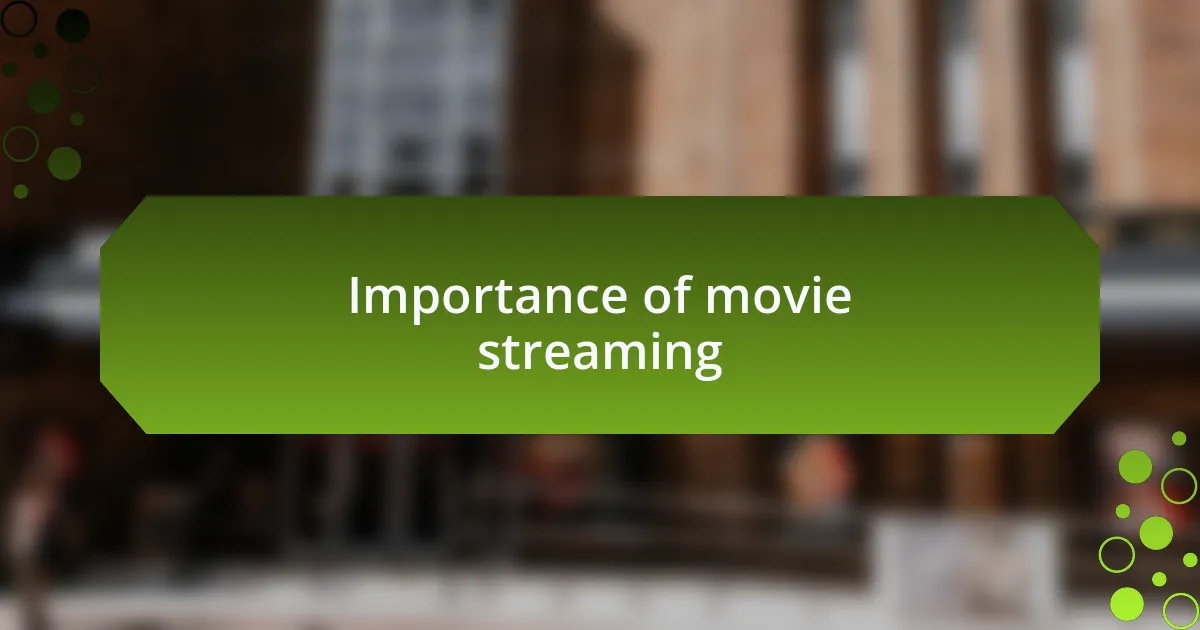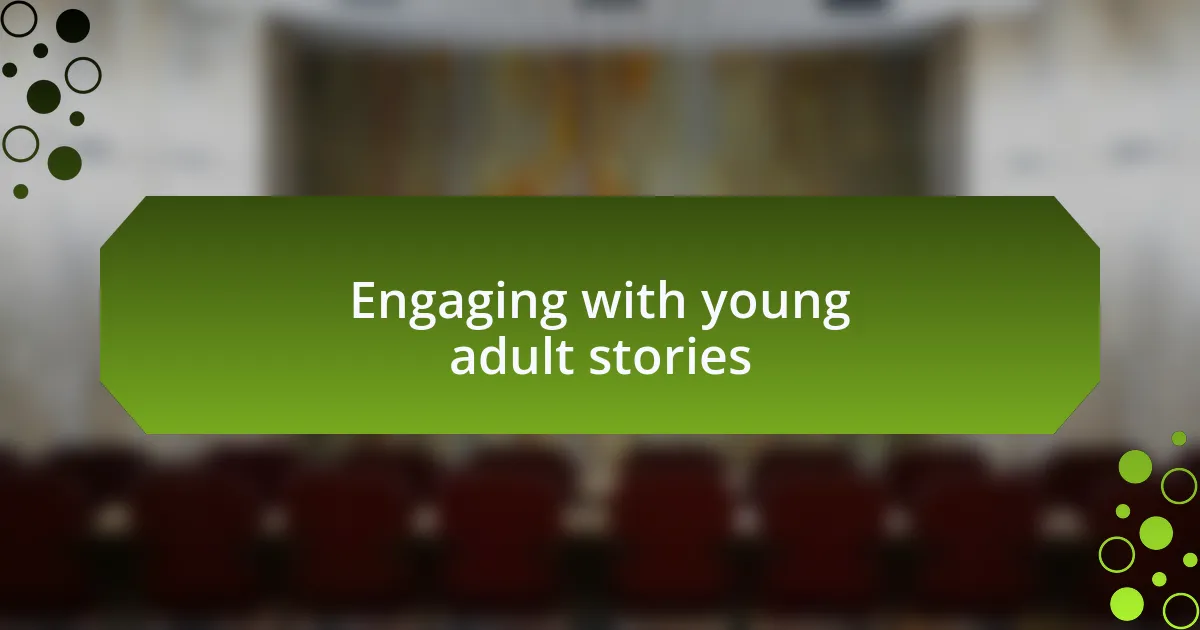Key takeaways:
- Young adult fiction resonates deeply due to its exploration of identity, emotional intensity, and universal themes like love and social issues, allowing readers to connect and revisit stories at different life stages.
- Movie streaming has revolutionized access to diverse films, fostering connections between viewers and democratizing content for independent filmmakers while enhancing shared viewing experiences.
- When choosing a streaming service, consider factors like exclusive content and user experience, which can significantly influence engagement with young adult adaptations.
- Engagement with young adult stories can evoke nostalgia and emotional connections, particularly when adaptations closely capture the essence of the original narratives.

Understanding young adult fiction
Young adult fiction often captures the essence of the transitional phase between adolescence and adulthood. I remember picking up my first YA novel and feeling an overwhelming sense of connection; the protagonists seemed so relatable, grappling with identity and the complexities of growing up. Isn’t it fascinating how these stories can mirror our own struggles, turning the page on our memories?
A defining characteristic of this genre is its raw emotional intensity. I often reflect on the moments when a character’s heartbreak felt like my own, evoking feelings that I hadn’t fully processed. It raises the question: why do we find such solace in these narratives? Perhaps it’s because YA fiction validates our experiences and emotions, reinforcing that growth often comes from pain and perseverance.
Moreover, young adult fiction isn’t confined to just one theme; it explores love, friendship, identity, and social issues, often pushing boundaries that resonate with both younger and older readers. I’ve found myself revisiting these stories as an adult, discovering new layers and insights that I missed as a teenager. Isn’t it wonderful how these narratives evolve with us, allowing for renewed understanding at different stages of life?

Importance of movie streaming
The significance of movie streaming lies in its ability to provide instant access to a vast array of films that cater to diverse tastes and preferences. I think back to those late nights when I’d be scrolling through endless titles, often stumbling across a hidden gem that transformed my perspective. Isn’t it remarkable how one film can evoke such a strong emotional response, making us laugh, cry, or reflect on our own experiences?
With streaming platforms, the boundaries of traditional viewing experiences disappear, allowing for flexibility in how and when we engage with stories. I recall the joy of hosting movie marathons with friends, each of us contributing personal favorites that sparked lively discussions. This shared experience not only deepened our connections but also reinforced the idea that movies can be a bridge between different generations and cultures.
Moreover, movie streaming is at the forefront of democratizing entertainment, enabling independent filmmakers to reach wider audiences. I’ve come across incredible stories from filmmakers who may not have had the chance to shine in traditional theaters. This accessibility raises questions about how we define success in cinema—could it be that the next great masterpiece is just a click away?

Popular young adult adaptations
When it comes to popular young adult adaptations, it’s hard to ignore the impact of franchises like “The Hunger Games.” I remember the thrill of watching Katniss Everdeen rise from the ashes of despair to become a symbol of hope. Each movie captivated not just with action-packed sequences but also with its poignant exploration of societal issues, making me reflect on the challenges faced by our own generation.
Another standout adaptation is “The Fault in Our Stars,” which beautifully captures the complexities of love and loss through the eyes of young cancer patients. I vividly recall sitting in a packed theater, moved to tears as the characters navigated their heartbreaking realities. It’s fascinating how such stories, though rooted in fiction, resonate deeply with real-life experiences of resilience and vulnerability among young adults.
Then there’s “To All the Boys I’ve Loved Before,” a delightful romantic comedy that resonates with those teenage crushes we all experienced. Watching Lara Jean’s journey unfold on screen took me back to my own high school days, filled with secret love letters and unspoken feelings. How often do we see ourselves in these stories that remind us of the joy and awkwardness of young love?

Choosing the right streaming service
Choosing a streaming service can feel overwhelming with so many options available today. I remember when I was searching for the right one, trying to balance budget, content quality, and the selection of young adult adaptations. It’s crucial to consider what specifically excites you within this genre; for instance, do you prefer gripping dystopian tales like “The Hunger Games” or the heartfelt narratives akin to “The Fault in Our Stars”?
Another important factor is exclusivity. I once discovered that a streaming platform had exclusive rights to a hotly anticipated adaptation. The thrill of being one of the first to dive into a new story kept me engaged and added an extra layer of excitement to my viewing experience. Have you ever waited eagerly for a particular adaptation? That anticipation can make all the difference in how we connect with these stories.
Lastly, think about the user experience. When I switched services, a more intuitive interface transformed my viewing habits; suddenly, I was exploring more content. It even sparked a newfound interest in adaptations I might not have pursued otherwise. Don’t underestimate how the overall experience of navigating a platform can enhance your connection to the stories you love.

Tips for discovering new titles
When it comes to discovering new titles, I find that exploring curated lists can be a game changer. Last month, I stumbled upon a “hidden gems” playlist on my streaming service, and it led me to an indie adaptation that left me breathless. Have you looked into such lists? They often highlight unique stories that might not make the mainstream wave, providing a refreshing change from the typical blockbusters.
Joining online communities or forums dedicated to young adult fiction can also yield incredible recommendations. I remember conversing with fellow fans about a book-to-film adaptation, and someone suggested a title I’d never even heard of. That one recommendation turned into a binge-worthy experience! Engaging with others not only expands your choices but also fosters a sense of camaraderie; have you ever felt the thrill of connecting over a shared interest?
Lastly, don’t underestimate the power of social media. Following authors, influencers, or even specific hashtags can keep you in the loop with what’s new and trending. I recall scrolling through my feed one evening and came across a post about an upcoming film adaptation that immediately caught my attention. The excitement of shared anticipation can transform your viewing journey, allowing you to dive into new titles alongside others. Are there particular social channels you prefer for keeping up with the latest in young adult adaptations?

Engaging with young adult stories
Engaging with young adult stories often evokes a wave of nostalgia for my own adolescence. I vividly remember staying up late, absorbed in a series that made me feel so understood. These tales resonate on a deeper level, reflecting the complexities of growing up. Have you ever lost track of time while reading a book that felt like it mirrored your experiences?
I also find that immersing myself in character-driven narratives enhances my emotional connection with the story. When I watch a young adult film, I often identify with the protagonist’s struggles and triumphs. Last year, I watched an adaptation where the main character faced bullying, and it stirred memories of my high school days. That relatability can truly amplify the impact of the story. Have you experienced a moment where a character’s journey mirrored your own?
Furthermore, I actively seek out adaptations that maintain the essence of the original narratives. I recall being pleasantly surprised by a recent film that stayed true to the book’s themes and messages. It was as if I was revisiting an old friend, and the cinematic experience brought the characters to life in a way that felt authentic. What adaptations have you seen that captured the heart of the story perfectly?

Personal experiences with adaptations
I’ve often found that adaptations can evoke a spectrum of emotions, transporting me back to my initial encounters with a beloved book. One adaptation that struck a chord was “The Fault in Our Stars.” I remember watching it in a packed theater, tears streaming down my face, reliving the bittersweet moments I had first encountered in print. The blend of laughter and heartbreak truly made me appreciate how hard it is to capture nuanced emotional arcs on screen.
In another instance, I went into the film adaptation of “To All the Boys I’ve Loved Before” with a bit of skepticism. The original book had captured my heart with its quirky charm. However, seeing it come to life revitalized those feelings. I couldn’t help but smile as Lara Jean navigated love and awkwardness—just like I had during my teenage years. Have you ever felt that familiar flutter of excitement when a story unfolds in a new way?
Sometimes, though, adaptations miss the mark completely. I recall the adaptation of “The Darkest Minds” leaving me feeling a bit disappointed. The emotional depth and character development that I had cherished in the book seemed lost in translation. It made me wonder: how can filmmakers truly honor the source material while also creating something fresh? That challenge often leaves me pondering the balance between innovation and fidelity in adaptations.